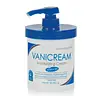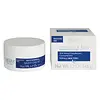What's inside
What's inside
 Key Ingredients
Key Ingredients

 Benefits
Benefits

 Concerns
Concerns

 Ingredients Side-by-side
Ingredients Side-by-side

Water
Skin ConditioningCaprylic/Capric Triglyceride
MaskingGlycerin
HumectantDicaprylyl Carbonate
EmollientCetearyl Alcohol
EmollientCetearyl Glucoside
EmulsifyingEthylhexyl Stearate
EmollientPanthenol
Skin ConditioningGlyceryl Stearate
EmollientGlyceryl Stearate Citrate
EmollientTocopheryl Acetate
AntioxidantLecithin
EmollientUbiquinone
AntioxidantPropylene Glycol
HumectantHelianthus Annuus Seed Oil
EmollientGlycine Soja Seed Extract
Skin ConditioningTriticum Vulgare Germ Extract
Skin ConditioningRetinyl Palmitate
Skin ConditioningRetinol
Skin ConditioningPersea Gratissima Oil
Skin ConditioningCarthamus Tinctorius Seed Oil
MaskingGlycine Soja Oil
EmollientGlycine Soja Sterols
EmollientC12-15 Alkyl Benzoate
AntimicrobialDimethicone
EmollientLinoleic Acid
CleansingLinolenic Acid
CleansingTocopherol
AntioxidantSodium Cetearyl Sulfate
CleansingSodium Hyaluronate
HumectantHexyl Laurate
EmollientAscorbic Acid
AntioxidantParfum
MaskingAscorbyl Palmitate
AntioxidantGlyceryl Oleate
EmollientDimethylmethoxy Chromanol
AntioxidantCitric Acid
BufferingSodium Hydroxide
BufferingHydrogenated Palm Glycerides Citrate
EmollientPropanediol
SolventAlcohol
AntimicrobialSorbitol
HumectantPhenoxyethanol
PreservativeAlcohol Denat.
AntimicrobialBenzoic Acid
MaskingDehydroacetic Acid
PreservativeSodium Benzoate
MaskingPotassium Sorbate
PreservativeSorbic Acid
PreservativeBenzyl Alcohol
PerfumingBHT
AntioxidantWater, Caprylic/Capric Triglyceride, Glycerin, Dicaprylyl Carbonate, Cetearyl Alcohol, Cetearyl Glucoside, Ethylhexyl Stearate, Panthenol, Glyceryl Stearate, Glyceryl Stearate Citrate, Tocopheryl Acetate, Lecithin, Ubiquinone, Propylene Glycol, Helianthus Annuus Seed Oil, Glycine Soja Seed Extract, Triticum Vulgare Germ Extract, Retinyl Palmitate, Retinol, Persea Gratissima Oil, Carthamus Tinctorius Seed Oil, Glycine Soja Oil, Glycine Soja Sterols, C12-15 Alkyl Benzoate, Dimethicone, Linoleic Acid, Linolenic Acid, Tocopherol, Sodium Cetearyl Sulfate, Sodium Hyaluronate, Hexyl Laurate, Ascorbic Acid, Parfum, Ascorbyl Palmitate, Glyceryl Oleate, Dimethylmethoxy Chromanol, Citric Acid, Sodium Hydroxide, Hydrogenated Palm Glycerides Citrate, Propanediol, Alcohol, Sorbitol, Phenoxyethanol, Alcohol Denat., Benzoic Acid, Dehydroacetic Acid, Sodium Benzoate, Potassium Sorbate, Sorbic Acid, Benzyl Alcohol, BHT
 Reviews
Reviews

Ingredients Explained
These ingredients are found in both products.
Ingredients higher up in an ingredient list are typically present in a larger amount.
BHT is a synthetic antioxidant and preservative.
As an antioxidant, it helps your body fight off free-radicals. Free-radicals are molecules that may damage your skin cells.
As a preservative, it is used to stabilize products and prevent them from degrading. Specifically, BHT prevents degradation from oxidation.
The concerns related to BHT come from oral studies; this ingredient is currently allowed for use by both the FDA and EU.
However, it was recently restricted for use in the UK as of April 2024.
Learn more about BHTCetearyl alcohol is a mixture of two fatty alcohols: cetyl alcohol and stearyl alcohol. It is mainly used as an emulsifier. Emulsifiers help prevent the separation of oils and products. Due to its composition, it can also be used to thicken a product or help create foam.
Cetearyl alcohol is an emollient. Emollients help soothe and hydrate the skin by trapping moisture.
Studies show Cetearyl alcohol is non-toxic and non-irritating. The FDA allows products labeled "alcohol-free" to have fatty alcohols.
This ingredient is usually derived from plant oils such as palm, vegetable, or coconut oils. There is debate on whether this ingredient will cause acne.
Due to the fatty acid base, this ingredient may not be Malassezia folliculitis safe.
Learn more about Cetearyl AlcoholGlyceryl Stearate is a mix of glycerin and stearic acid.
It is used to stabilize the mixing of water and oil ingredients. By preventing these ingredients from separating, it can help elongate shelf life. It can also help thicken the product's texture.
As an emollient, it helps soften skin and supports barrier-replenishing ingredients.
In cosmetics, Glyceryl Stearate is often made from vegetable oils or synthetically produced.
This ingredient may not be fungal-acne safe
Fun fact: The human body also creates Glyceryl Stearate naturally.
Learn more about Glyceryl StearatePropylene Glycol is an odorless, colorless liquid. As a humectant, it helps skin retain moisture. It also aids in delivering active ingredients.
Another role of this ingredient is preventing a product from melting or freezing. Propylene glycol also adds antimicrobrial properties to a product, elongating product lifespan.
This ingredient is considered an organic alcohol and commonly added into both cosmetics and foods.
Those with sensitive skin or conditions may develop a rash when using this ingredient.
Learn more about Propylene GlycolSorbic Acid is a preservative. It is the most commonly used food preservative in the world.
Sorbic Acid is a natural antibiotic and highly effective at preventing the growth of fungus. It is less effective against bacteria.
Potassium Sorbate, another commonly-used preservative, is the potassium salt of Sorbic Acid.
Sorbic Acid may worsen eczema. We recommend speaking with a professional if you have any concerns.
Potassium sorbate and sorbic acid can be found in baked goods, cheeses, dried meats, dried fruit, ice cream, pickles, wine, yogurt, and more.
Learn more about Sorbic AcidSorbitol is a sugar alcohol. It is a hydrating and moisturizing agent created from the reduction process of glucose.
Most sorbitol is usually made from potato starch. It is also found in fruits such as apples and pears.
As a humectant, Sorbitol helps draw water to the skin. This helps keep the skin hydrated. Sorbitol also helps create a thicker texture in products. You might find sorbitol in your toothpaste and other gels.
It is a non-irritating ingredient that is great for those with dry skin.
Sorbitol is a prebiotic. It helps promote the growth of healthy bacteria on your skin. The bacteria on your skin form a microbiome. This microbiome helps protect your skin from infection and harmful bacteria.
Learn more about SorbitolWater. It's the most common cosmetic ingredient of all. You'll usually see it at the top of ingredient lists, meaning that it makes up the largest part of the product.
So why is it so popular? Water most often acts as a solvent - this means that it helps dissolve other ingredients into the formulation.
You'll also recognize water as that liquid we all need to stay alive. If you see this, drink a glass of water. Stay hydrated!
Learn more about Water